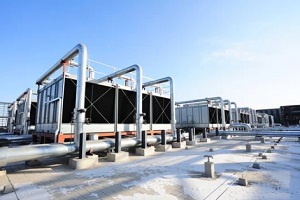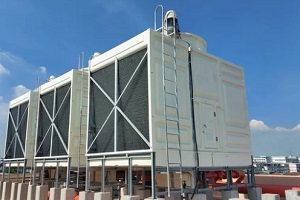 Cooling towers are integral components of many building systems, serving as the heart of the cooling process and playing a pivotal role in ensuring the comfort, safety, and efficiency of the buildings they support. As a building owner or manager, it is important to prepare your tower for when the colder months approach.
Cooling towers are integral components of many building systems, serving as the heart of the cooling process and playing a pivotal role in ensuring the comfort, safety, and efficiency of the buildings they support. As a building owner or manager, it is important to prepare your tower for when the colder months approach.
Neglecting the winterization of cooling towers isn’t just about risking breakdowns or costly repairs, it’s also about safeguarding against potential outages that can disrupt building operations or, even worse, the proliferation of health hazards including Legionella bacteria, which thrive in stagnant water, posing serious health risks to occupants.
The timing of the winterization process is key to proper maintenance, and this article aims to guide you through the when and how, ensuring that your cooling tower remains not just operational, but efficient and safe throughout the winter season.
If your building is, as many are at this time, understaffed, relying on experienced professionals can take the burden of this requirement from your staff. Whether you are performing the necessary steps in-house, or want to delegate to professionals, understanding the following can be beneficial.
Understanding The Winterization Timeline
Understanding the right timeline for carrying out key tasks is essential for the effective winterization of your cooling tower. In areas like the northeast which experience harsher winters, preparations should ideally start by mid to late September.
The exact time for the lay-up of systems largely relies on the weather, but usually, this is an October activity. By the end of the year, all systems destined to be shut down for the winter should undergo this process.
However, for those systems that are set to operate continuously through the winter, a modified version of the winterization process should be executed before the continuation of treatment during the colder winter months.
For systems that undergo winterizing with antifreeze or glycol, the timing, although still weather-dependent, tends to fall between mid-October through December. It’s often beneficial for this task to coincide with the lay-up process to help maximize efficiency.
Key Winterization Tasks For Your Cooling Tower
As winter edges closer, ensuring that your cooling tower is well-prepared to face the harsh conditions helps to ensure its operational efficiency. Performing key winterization tasks can help improve the system’s longevity and optimal, efficient performance.
To help you as a building owner or property manager, here is a slightly more detailed guide on the essential steps to kickstart your winterization process:
- Determine the System Fluid: Before making any adjustments, it’s important to identify whether you are running ethylene glycol or propylene through your building’s hot and chilled water systems. The fluid type in your system can greatly influence the subsequent maintenance and treatment processes.
- Comprehensive Water Testing: Don’t just test your water; understand it. Conducting a comprehensive water test lets you gauge its current quality, pinpoint potential issues, and devise a plan to address any imbalances or impurities.
- Cleaning, Disinfection, and Passivation: Open systems, such as cooling towers, are more vulnerable to contaminants, scale build-up, and microbial growth. It’s essential to undertake a rigorous cleaning and disinfection regimen. Passivating the system ensures a protective oxide layer forms on metal surfaces, preventing corrosion and enhancing system life.
- Inspect for Vulnerabilities: Beyond the steps above, conduct a thorough inspection to identify any potential vulnerabilities in the system— leaks, wear and tear, or any parts needing replacement. Addressing these issues proactively will prevent larger complications in the midst of winter.
- Layup of System: Layup protects the tower while offline and allows for maintenance, to extend the life of the cooling tower and avoid costly repairs from damage during downtime. The chemicals and preparations depend on the climate and length of layup. This includes draining the basin, adding layup chemicals to prevent corrosion and biological growth, and implementing freeze protection measures if needed.
Avoiding Winterization Pitfalls
 It simply can not be stressed enough just how pivotal the annual cleaning and winterization process is. Neglecting the process, even once, can lead to complications during the winter months and set the stage for challenges in the forthcoming cooling seasons. The operational window for performing winterization may be short, but the impact affects the entire season.
It simply can not be stressed enough just how pivotal the annual cleaning and winterization process is. Neglecting the process, even once, can lead to complications during the winter months and set the stage for challenges in the forthcoming cooling seasons. The operational window for performing winterization may be short, but the impact affects the entire season.
For any facility, having an efficient and timely winterization process isn’t just about ensuring that the cooling towers and systems operate seamlessly. It’s about guaranteeing their longevity, efficiency, and, above all, the safety and comfort of the building’s occupants.
Keeping Your Cooling Tower Winter-Ready
Ensuring your cooling tower’s optimal performance during the cold months isn’t just a technical task; it’s a commitment to comfort and safety. Our team of experienced tech professionals are here to ensure you take the appropriate steps to protect your HVAC system all year long.
At Tower Water, we pride ourselves on creating lasting partnerships by offering tailored solutions addressing your unique challenges. Want a one-stop solution for all your water treatment needs? Contact Tower Water today at 212-518-6475 or book a consultation online to learn more about how we can serve you.
